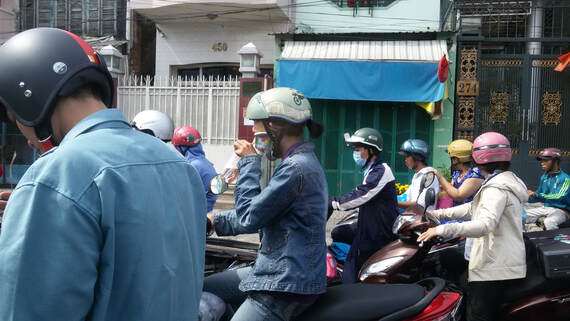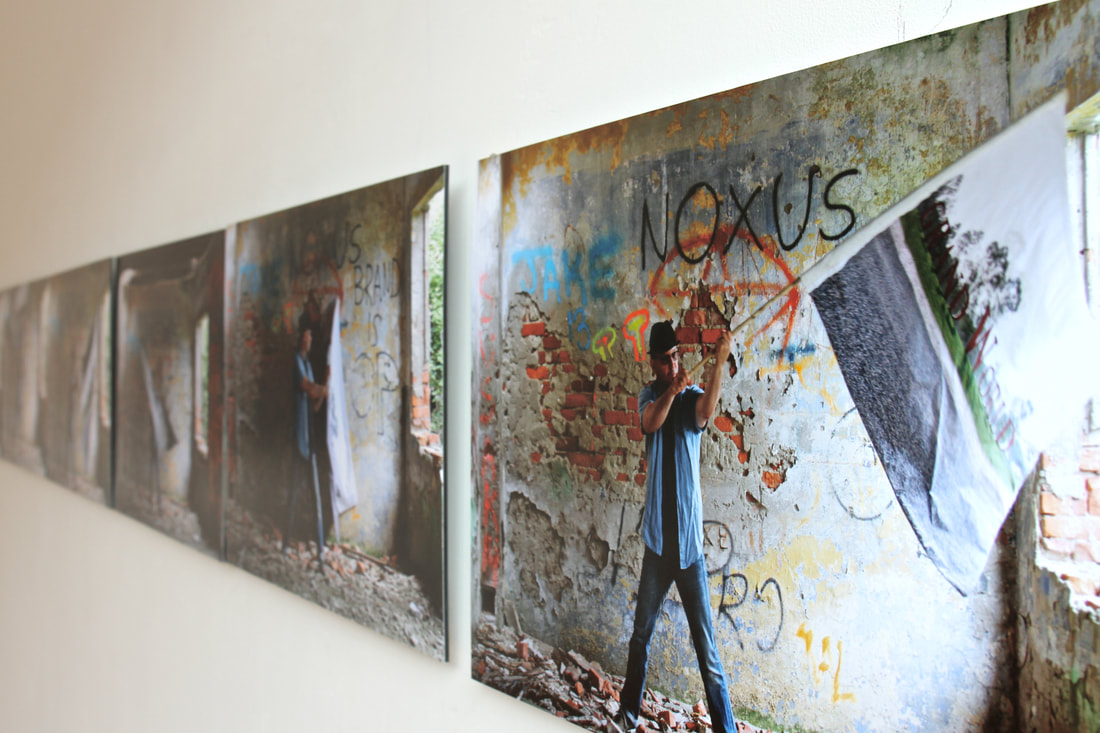The search for Grand World is an investigation into a tale of two islands.
Susak island, Grand World processes, Croatia, 2016
"My motivation was to find a way to montage two very unlikely narratives, ones that would conceptually resonate somewhere between Robert Sherman's composition "It’s a Small World After All” (Mary Poppins), and Marshall McLuhan’s theory of "the global village".
Comprised of photographic documentation of the flag in action, videos on Lewis' involvement in past and recent Susak Expos (Crotia), and a separate video in Cambodia, the installation is consistent conceptually with his earlier practice. Like other works, GRAND WORLD doesn’t seek to delineate a specific reading of contemporary reality and cultural politics, but rather uses a range of artistic tools to establish a new social experience that fractures the path of the daily routine and invites and even relies on a reaction from the public: something at play both in the way the flag functioned as a confrontational but absurd marker in Susak and how the installation solicits an answer to the implicit question: Is it a grand world we live in? Is it here where I stand? We confront these questions from the necessarily limited view of our individual location (both geographically and culturally): something that the radical dislocation inherent in Lewis’ movement of the phrase “grand word” highlights. Judith Schalansky writing in her Atlas of Remote Islands states: “Whether an island such as Easter Island can be considered remote is simply a matter of perspective. Those who live there, the Rapa Nui, call their homeland Te Pito Te Henua, 'the navel of the world.' Any point on the infinite globe of the Earth can become a centre” (Penguin; 2009). Lewis in his own way is asking us to consider the place where we are as the centre and to reflect on it critically, rather than imagining a faraway paradise: the place we live rather than the place we hope to reach. Situationally responsive, and far too reactive to immediate circumstances to fuss towards a sealed aesthetic refinement in the studio, his practice builds out of what he finds out there, offering it as a mechanism of discovery and challenge.
Gordon Laurin
Beijing, June 2016
here to edit.
Comprised of photographic documentation of the flag in action, videos on Lewis' involvement in past and recent Susak Expos (Crotia), and a separate video in Cambodia, the installation is consistent conceptually with his earlier practice. Like other works, GRAND WORLD doesn’t seek to delineate a specific reading of contemporary reality and cultural politics, but rather uses a range of artistic tools to establish a new social experience that fractures the path of the daily routine and invites and even relies on a reaction from the public: something at play both in the way the flag functioned as a confrontational but absurd marker in Susak and how the installation solicits an answer to the implicit question: Is it a grand world we live in? Is it here where I stand? We confront these questions from the necessarily limited view of our individual location (both geographically and culturally): something that the radical dislocation inherent in Lewis’ movement of the phrase “grand word” highlights. Judith Schalansky writing in her Atlas of Remote Islands states: “Whether an island such as Easter Island can be considered remote is simply a matter of perspective. Those who live there, the Rapa Nui, call their homeland Te Pito Te Henua, 'the navel of the world.' Any point on the infinite globe of the Earth can become a centre” (Penguin; 2009). Lewis in his own way is asking us to consider the place where we are as the centre and to reflect on it critically, rather than imagining a faraway paradise: the place we live rather than the place we hope to reach. Situationally responsive, and far too reactive to immediate circumstances to fuss towards a sealed aesthetic refinement in the studio, his practice builds out of what he finds out there, offering it as a mechanism of discovery and challenge.
Gordon Laurin
Beijing, June 2016
here to edit.

In 2006 and again in 2014, by invitation, I travelled to Susak, Croatia to be part of an Art Expo, but it was not until my second trip that I realized how similar Susak was to Phú Quôc. Both are ancient islands surviving with fishing and other smaller exports. They are both far enough from mainland and historically, they operated independently from mainland. Unlike Phú Quôc, Susak does not allow cars on the island, and until recently, has avoided tourism in the form of hotels. Now, expensive yachts, owned by the likes of Tom Cruise and Russian oligarchs, are visiting the shoreline and docking at its port. The elders of Susak are fighting change, but it seems inevitable.
Grand World is my investigation into two islands worlds apart, but confronted by similar present and historical challenges: gentrification's threat and loss of deep traditions, graft and war. My goal was to close geographic gaps between these two islands in order to develop some form of narrative that would represent their cultural upheaval. In 2015, my partner and I travelled to Vietnam, to Phú Quôc Island off the coast of Cambodia and on the Gulf of Thailand. We travelled by motorcycle through fishing villages, quietly exploring the lives of the local people. Travelling up island to the flatlands, we came across an unusual grassy hill, surrounded by pebbles and stone as well as a huge cement parking lot. It seemed to be the precursor to Phú Quôc's future. On top of the hill stood 5-foot letters spelling out “GRAND WORLD” and we had no idea what it meant. GRAND WORLD stood there looking more like a Barbra Kruger text sculpture. Through our conversations with locals, we were able to understand that Phú Quôc was at the beginning of "exciting changes" that would bring tourism and development — saving Phú Quôc from a turbulent past. One local said it with glee, and the another was skeptical. We learned that GRAND WORLD was the name of a new golf course and amusement park. Today, Phú Quôc is a tourist island and has a yearly music festival.

Phu Quoc island, Golden World land development and fishing villages, 2014
Historically, both Phú Quôc and Susak are in stark contrast to their pasts. In the 17th century, the French built prisons on Phú Quôc island to house fighting Vietnamese who were trying to protect their country from the French and the tin trade. Later, Khmer Rouge (Pol Pot) used the island for jailing Cambodians, and the Americans used it to jail the Vietcong. Likewise, Susak was under the Roman Empire and was used for a shipping port. Later, it was given by the Napoleon Empire to Mussolini in Italy, who built prisons on it in World War 2. Under President Tito’s Socialist regime, the island was used as a prison for anyone that decented from ideologies of "his" Yugoslavia.
Grand World flag, in-situ, Susak, Croatia, 2016
Grand World installation, Unit #1 Gallery, Beijing, China, 2015
Tito’s Prison in Grand World, 7 digital photographs on aluminium, 50”x60”, 2015

